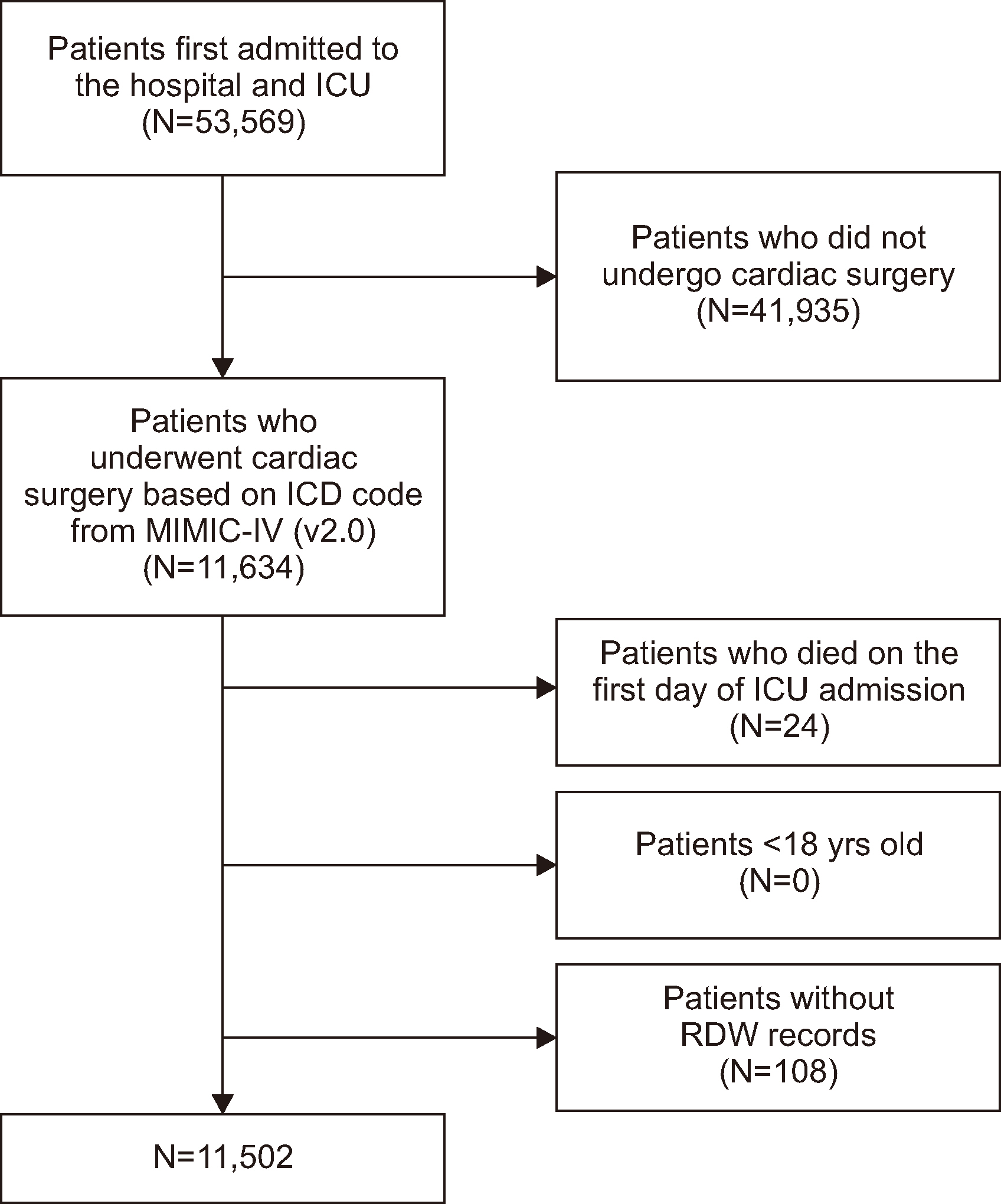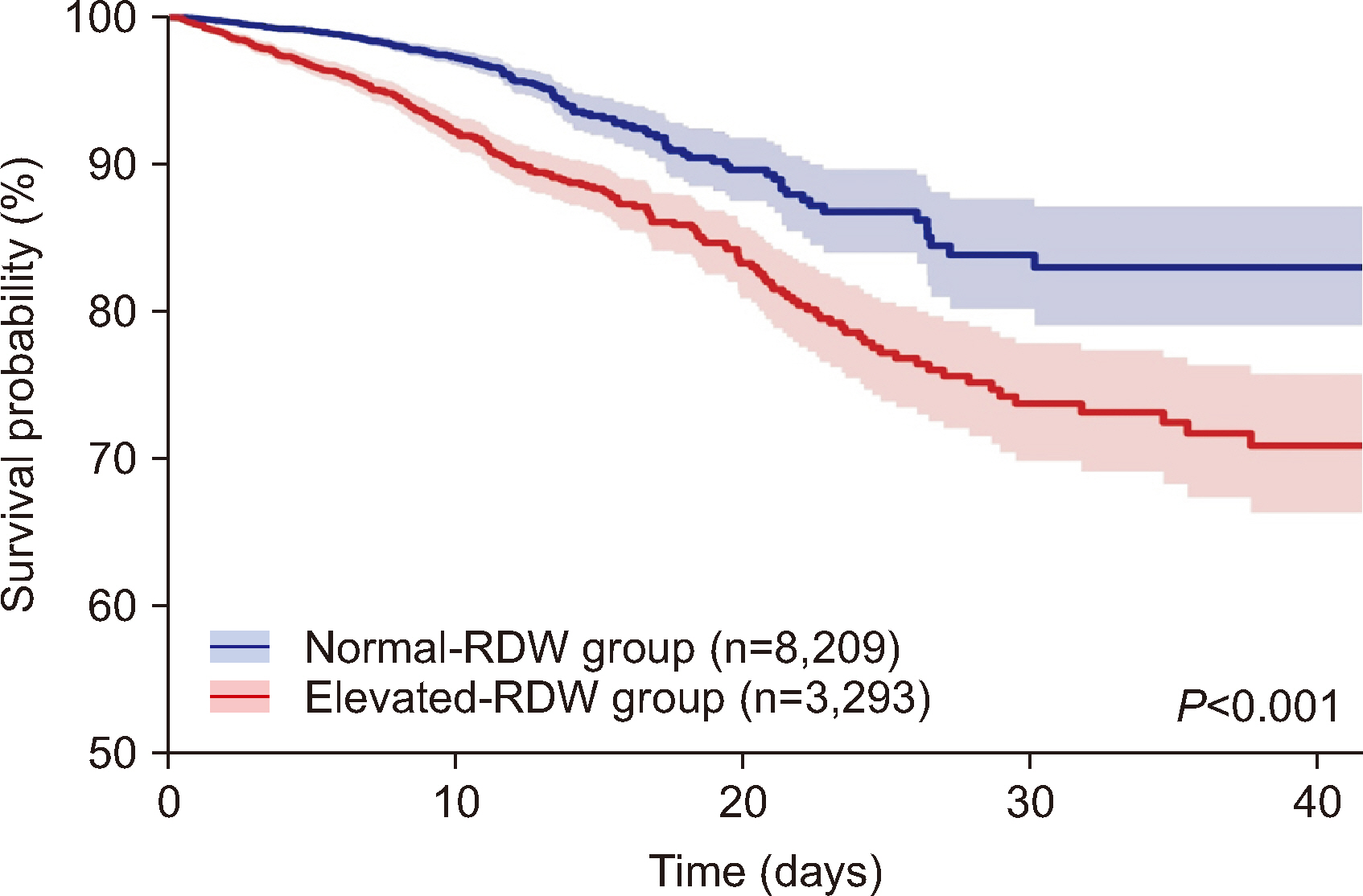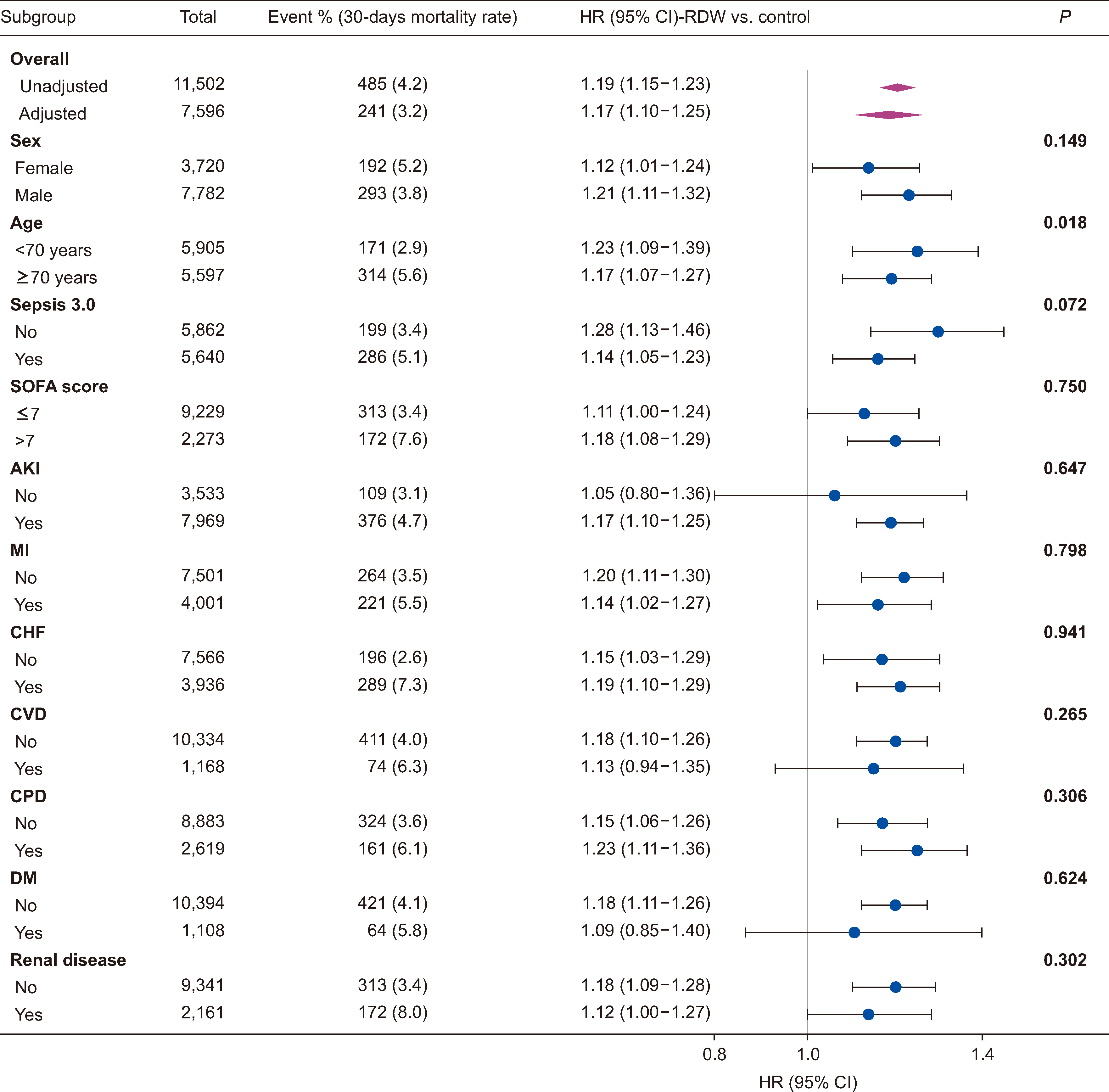Ann Lab Med.
2024 Sep;44(5):401-409. 10.3343/alm.2023.0345.
Association Between the Red Blood Cell Distribution Width and 30-Day Mortality in Intensive Care Patients Undergoing Cardiac Surgery: A Retrospective Observational Study Based on the Medical Information Mart for Intensive Care-IV Database
- Affiliations
-
- 1Department of Anaesthesiology, Shantou Central Hospital, Shantou, Guangdong, China
- 2Department of Anaesthesiology, Third People’s Hospital of Chengdu, Affiliated Hospital of Southwest Jiaotong University, Chengdu, Sichuan, China
- 3Department of Anaesthesiology, the Third Affiliated Hospital of Sun Yat-Sen University, Guangdong, China
- KMID: 2559146
- DOI: http://doi.org/10.3343/alm.2023.0345
Abstract
- Background
Millions of patients undergo cardiac surgery each year. The red blood cell distribution width (RDW) could help predict the prognosis of patients who undergo percutaneous coronary intervention or coronary artery bypass surgery. We investigated whether the RDW has robust predictive value for the 30-day mortality among patients in an intensive care unit (ICU) after undergoing cardiac surgery.
Methods
Using the Medical Information Mart for Intensive Care-IV Database, we retrieved data for 11,634 patients who underwent cardiac surgery in an ICU. We performed multivariate Cox regression analysis to model the association between the RDW and 30-day mortality and plotted Kaplan–Meier curves. Subgroup analyses were stratified using relevant covariates. Receiver operating characteristic (ROC) curves were used to determine the predictive value of the RDWs.
Results
The total 30-day mortality rate was 4.2% (485/11,502). The elevated-RDW group had a higher 30-day mortality rate than the normal-RDW group (P < 0.001). The robustness of our data analysis was confirmed by performing subgroup analyses. Each unit increase in the RDW was associated with a 17% increase in 30-day mortality when the RDW was used as a continuous variable (adjusted hazard ratio = 1.17, 95% confidence interval, 1.10–1.25). Our ROC results showed the predictive value of the RDW.
Conclusions
An elevated RDW was associated with a higher 30-day mortality in patients after undergoing cardiac surgery in an ICU setting. The RDW can serve as an efficient and accessible method for predicting the mortality of patients in ICUs following cardiac surgery.
Keyword
Figure
Reference
-
References
1. Mozaffarian D, Benjamin EJ, Go AS, Arnett DK, Blaha MJ, et al. Writing Group Members. 2016; Heart disease and stroke statistics-2016 update: a report from the American Heart Association. Circulation. 133:e38–360. DOI: 10.1161/CIR.0000000000000350. PMID: 26673558.2. Landoni G, Lomivorotov V, Silvetti S, Nigro Neto C, Pisano A, Alvaro G, et al. 2018; Nonsurgical strategies to reduce mortality in patients undergoing cardiac surgery: an updated consensus process. J Cardiothorac Vasc Anesth. 32:225–35. DOI: 10.1053/j.jvca.2017.06.017. PMID: 29122431.
Article3. Lazam S, Vanoverschelde JL, Tribouilloy C, Grigioni F, Suri RM, Avierinos JF, et al. 2017; Twenty-year outcome after mitral repair versus replacement for severe degenerative mitral regurgitation: analysis of a large, prospective, multicenter, international registry. Circulation. 135:410–22. DOI: 10.1161/CIRCULATIONAHA.116.023340. PMID: 27899396.
Article4. Pieri M, Belletti A, Monaco F, Pisano A, Musu M, Dalessandro V, et al. 2016; Outcome of cardiac surgery in patients with low preoperative ejection fraction. BMC Anesthesiol. 16:97. DOI: 10.1186/s12871-016-0271-5. PMID: 27760527. PMCID: PMC5069974.
Article5. Nashef SAM, Roques F, Sharples LD, Nilsson J, Smith C, Goldstone AR, et al. 2012; EuroSCORE II. Eur J Cardiothorac Surg. 41:734–45. DOI: 10.1093/ejcts/ezs043. PMID: 22378855.
Article6. Carino D, Denti P, Ascione G, Del Forno B, Lapenna E, Ruggeri S, et al. 2021; Is the EuroSCORE II reliable in surgical mitral valve repair? A single-centre validation study. Eur J Cardiothorac Surg. 59:863–8. DOI: 10.1093/ejcts/ezaa403. PMID: 33313790.
Article7. Pinna A, Carlino P, Serra R, Boscia F, Dore S, Carru C, et al. 2021; Red cell distribution width (RDW) and complete blood cell count-derived measures in non-arteritic anterior ischemic optic neuropathy. Int J Med Sci. 18:2239–44. DOI: 10.7150/ijms.53668. PMID: 33859533. PMCID: PMC8040420.
Article8. Qi X, Dong Y, Lin X, Xin W. 2021; Value of neutrophil to lymphocyte ratio, platelet to lymphocyte ratio, and red blood cell distribution width in evaluating the prognosis of children with severe pneumonia. Evid Based Complement Alternat Med. 2021:1818469. DOI: 10.1155/2021/1818469. PMID: 34603463. PMCID: PMC8486541.
Article9. Salvagno GL, Sanchis-Gomar F, Picanza A, Lippi G. 2015; Red blood cell distribution width: a simple parameter with multiple clinical applications. Crit Rev Clin Lab Sci. 52:86–105. DOI: 10.3109/10408363.2014.992064. PMID: 25535770.
Article10. Xanthopoulos A, Giamouzis G, Dimos A, Skoularigki E, Starling RC, Skoularigis J, et al. 2022; Red blood cell distribution width in heart failure: pathophysiology, prognostic role, controversies and dilemmas. J Clin Med. 11:1951. DOI: 10.3390/jcm11071951. PMID: 35407558. PMCID: PMC8999162. PMID: f95e06d778b84d5cac31e74e6900cfe5.
Article11. Huang S, Zhou Q, Guo N, Zhang Z, Luo L, Luo Y, et al. 2021; Association between red blood cell distribution width and in-hospital mortality in acute myocardial infarction. Medicine. 100:e25404. DOI: 10.1097/MD.0000000000025404. PMID: 33847638. PMCID: PMC8052072.
Article12. Singer M, Deutschman CS, Seymour CW, Shankar-Hari M, Annane D, Bauer M, et al. 2016; The third international consensus definitions for sepsis and septic shock (Sepsis-3). JAMA. 315:801–10. DOI: 10.1001/jama.2016.0287. PMID: 26903338. PMCID: PMC4968574.
Article13. Warwick R, Mediratta N, Shaw M, McShane J, Pullan M, Chalmers J, et al. 2013; Red cell distribution width and coronary artery bypass surgery. Eur J Cardiothorac Surg. 43:1165–9. DOI: 10.1093/ejcts/ezs609. PMID: 23277431.
Article14. Frentiu AA, Mao K, Caruana CB, Raveendran D, Perry LA, Penny-Dimri JC, et al. 2023; The prognostic significance of red cell distribution width in cardiac surgery: a systematic review and meta-analysis. J Cardiothorac Vasc Anesth. 37:471–9. DOI: 10.1053/j.jvca.2022.11.015. PMID: 36635145.
Article15. Johnson AEW, Bulgarelli L, Shen L, Gayles A, Shammout A, Horng S, et al. 2023; MIMIC-IV, a freely accessible electronic health record dataset. Sci Data. 10:1. DOI: 10.1038/s41597-022-01899-x. PMID: 36596836. PMCID: PMC9810617. PMID: 87ad030cf80044449c8297af0def7c70.
Article16. von Elm E, Altman DG, Egger M, Pocock SJ, Gøtzsche PC, Vandenbroucke JP, et al. 2007; Strengthening the Reporting of Observational Studies in Epidemiology (STROBE) statement: guidelines for reporting observational studies. BMJ. 335:806–8. DOI: 10.1136/bmj.39335.541782.AD. PMID: 17947786. PMCID: PMC2034723.
Article17. Yang Q, Zheng J, Chen W, Chen X, Wen D, Chen W, et al. 2021; Association between preadmission metformin use and outcomes in intensive care unit patients with sepsis and type 2 diabetes: a cohort study. Front Med (Lausanne). 8:640785. DOI: 10.3389/fmed.2021.640785. PMID: 33855034. PMCID: PMC8039324. PMID: 6e49fd9b118647e8b4a0e46370772e7e.
Article18. Otero TM, Canales C, Yeh DD, Hou PC, Belcher DM, Quraishi SA. 2016; Elevated red cell distribution width at initiation of critical care is associated with mortality in surgical intensive care unit patients. J Crit Care. 34:7–11. DOI: 10.1016/j.jcrc.2016.03.005. PMID: 27288601. PMCID: PMC4903153.
Article19. Shao Q, Korantzopoulos P, Letsas KP, Tse G, Hong J, Li G, et al. 2018; Red blood cell distribution width as a predictor of atrial fibrillation. J Clin Lab Anal. 32:e22378. DOI: 10.1002/jcla.22378. PMID: 29315856. PMCID: PMC6817116.
Article20. Ling J, Liao T, Wu Y, Wang Z, Jin H, Lu F, et al. 2021; Predictive value of red blood cell distribution width in septic shock patients with thrombocytopenia: a retrospective study using machine learning. J Clin Lab Anal. 35:e24053. DOI: 10.1002/jcla.24053. PMID: 34674393. PMCID: PMC8649348.
Article21. Pinho J, Silva L, Quintas-Neves M, Marques L, Amorim JM, Reich A, et al. 2021; Red cell distribution width is associated with 30-day mortality in patients with spontaneous intracerebral hemorrhage. Neurocrit Care. 34:825–32. DOI: 10.1007/s12028-020-01103-1. PMID: 32959199. PMCID: PMC8179905.
Article22. Smirne C, Grossi G, Pinato DJ, Burlone ME, Mauri FA, Januszewski A, et al. 2015; Evaluation of the red cell distribution width as a biomarker of early mortality in hepatocellular carcinoma. Dig Liver Dis. 47:488–94. DOI: 10.1016/j.dld.2015.03.011. PMID: 25864774.
Article23. Drakopoulou M, Toutouzas K, Stefanadi E, Tsiamis E, Tousoulis D, Stefanadis C. 2009; Association of inflammatory markers with angiographic severity and extent of coronary artery disease. Atherosclerosis. 206:335–9. DOI: 10.1016/j.atherosclerosis.2009.01.041. PMID: 19264307.
Article24. Arbel Y, Birati EY, Finkelstein A, Halkin A, Berliner S, Katz BZ, et al. 2014; Red blood cell distribution width and 3-year outcome in patients undergoing cardiac catheterization. J Thromb Thrombolysis. 37:469–74. DOI: 10.1007/s11239-013-0964-2. PMID: 23836454.
Article25. Maluf CB, Barreto SM, Giatti L, Ribeiro AL, Vidigal PG, Azevedo DRM, et al. 2020; Association between C reactive protein and all-cause mortality in the ELSA-Brasil cohort. J Epidemiol Community Health. 74:421–7. DOI: 10.1136/jech-2019-213289. PMID: 32102838. PMCID: PMC7307658.
Article26. Lindmark E, Diderholm E, Wallentin L, Siegbahn A. 2001; Relationship between interleukin 6 and mortality in patients with unstable coronary artery disease: effects of an early invasive or noninvasive strategy. JAMA. 286:2107–13. DOI: 10.1001/jama.286.17.2107. PMID: 11694151.
Article27. Fibach E, Rachmilewitz E. 2008; The role of oxidative stress in hemolytic anemia. Curr Mol Med. 8:609–19. DOI: 10.2174/156652408786241384. PMID: 18991647.
Article28. Ghaffari S. 2008; Oxidative stress in the regulation of normal and neoplastic hematopoiesis. Antioxid Redox Signal. 10:1923–40. DOI: 10.1089/ars.2008.2142. PMID: 18707226. PMCID: PMC2932538.
Article29. Weimann A, Braga M, Carli F, Higashiguchi T, Hübner M, Klek S, et al. 2021; ESPEN practical guideline: clinical nutrition in surgery. Clin Nutr. 40:4745–61. DOI: 10.1016/j.clnu.2021.03.031. PMID: 34242915.
Article30. Devereaux PJ, Lamy A, Chan MTV, Allard RV, Lomivorotov VV, Landoni G, et al. 2022; High-sensitivity troponin I after cardiac surgery and 30-day mortality. N Engl J Med. 386:827–36. DOI: 10.1056/NEJMoa2000803. PMID: 35235725.
Article31. Liu X, Xie L, Zhu W, Zhou Y. 2020; Association of body mass index and all-cause mortality in patients after cardiac surgery: a dose-response meta-analysis. Nutrition. 72:110696. DOI: 10.1016/j.nut.2019.110696. PMID: 32007807.
Article32. Zante B, Reichenspurner H, Kubik M, Kluge S, Schefold JC, Pfortmueller CA. 2018; Base excess is superior to lactate-levels in prediction of ICU mortality after cardiac surgery. PLoS One. 13:e0205309. DOI: 10.1371/journal.pone.0205309. PMID: 30289956. PMCID: PMC6173442. PMID: ee629989b9aa4ab397e6409916e20812.
Article33. Bouma HR, Mungroop HE, Scheeren TWL, Epema AH. 2021; Very early creatinine changes and 30-day mortality after cardiac surgery. Eur J Anaesthesiol. 38:665. DOI: 10.1097/EJA.0000000000001436. PMID: 33967257.
Article34. Yu Y, Peng C, Zhang Z, Shen K, Zhang Y, Xiao J, et al. 2022; Machine learning methods for predicting long-term mortality in patients after cardiac surgery. Front Cardiovasc Med. 9:831390. DOI: 10.3389/fcvm.2022.831390. PMID: 35592400. PMCID: PMC9110683. PMID: ce2a375dab0f43a681805eb2e558676f.
Article
- Full Text Links
- Actions
-
Cited
- CITED
-
- Close
- Share
- Similar articles
-
- Early bronchoscopy in severe pneumonia patients in intensive care unit: insights from the Medical Information Mart for Intensive Care-IV database analysis
- Increased red cell distribution width predicts mortality in COVID-19 patients admitted to a Dutch intensive care unit
- Impact of Socioeconomic Status on 30-Day and 1-Year Mortalities after Intensive Care Unit Admission in South Korea: A Retrospective Cohort Study
- Prognostic value of admission base excess in postoperative outcomes of aortic dissection patients: a retrospective cohort analysis
- Association between Hypophosphatemia and Cardiac Arrhythmias in the Early Stage of Sepsis: Could Phosphorus Replacement Treatment Reduce the Incidence of Arrhythmias?




